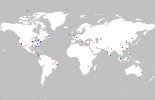_http://www.bordermail.com.au/story/1273425/dead-fish-a-mystery/?cs=2452Dead fish a mystery
Thousands of fish have mysteriously washed up dead on the shores of Burrinjuck Dam in south-east NSW.
Liz Richardson from Good Hope Tourist Resort said the amount of dead fish was “unbelievable”.
“Every type of fish,” she said. “Lots of baby fish, lots of small cod.”
Around eight kilometres of shoreline, downstream of Taemas Bridge and past Good Hope, was littered with fish carcasses.
The Department of Primary Industries said the cause of the fish kill was unclear.
Fisheries officers inspected the site on Tuesday and observed hundreds of native golden perch and Murray cod among the thousands of dead fish.
“Sizes of fish affected ranged from 5cm-80cm.
”The fish were observed floating in the water, along the waters edge and on the shoreline over an area of approximately eight kilometres within the impoundment,” a DPI spokesman said.
Ms Richardson said a similar thing happened about 10 years ago when the water levels were low, and heavy rain had fallen.
She believed the deaths were due to the rapidly falling dam levels, which, combined with recent storm run off, may have created low oxygen supplies in the dam.
“They’ve taken the water so dangerously low for the fish… they’ve ravaged the water,” she said.
“In three-and-a-half months [the lake’s] gone from 100 per cent to 38 per cent [full].
“We’ve had big rain before,” she said. “Like last year with the floods. It’s just the fact they’ve let all the water out.”
Dean Brind from Burrinjuck State Park said the falling water level shouldn’t have killed the fish.
“The fish normally will keep moving down unless they get stuck in pockets,” Mr Brind said.
He was told the first dead fish appeared Saturday morning before the rain. He didn’t know the cause but ruled out several factors.
“It’s not cold water, it’s not run off from the fires,” he said, as the fire run-off would have washed into the dam from the Yass River area.
Officers from the Environment Protection Authority (EPA) took water samples from Hume Park on Wednesday.
“Fisheries have let us know there’s been a fish kill,” head of operations, Sandie Jones, said.
“When there’s no clear cause we’ll come out to take samples.”
Hume Park management was worried about people wanting to use the dam.
“[There’s] concern as to why it has occurred and whether or not it is safe for recreational use.”
Resort owners will be rolling up their sleeves to clean up the dead fish in their immediate area. It is not known who is responsible for the clean up of the rest of the affected area.
Fishing takes a hit
Thousands of cod fingerlings released recently may all lay dead on the banks of Burrinjuck Dam.
Dean Brind from Burrinjuck State Park said around 65,000 cod were released before Christmas and just last week there was a trout release.
“Most of them were in that stretch of river,” he said. “That’s probably wiped those two releases out.
“That’s a year we’ve lost.”
You are using an out of date browser. It may not display this or other websites correctly.
You should upgrade or use an alternative browser.
You should upgrade or use an alternative browser.
Mystery of falling dead birds and masses of dead fish
- Thread starter wanderer33
- Start date
The herring apocalypse: Fish worth millions in exports die in Icelandic lake after building work 'starves them of oxygen'
Fish worth nearly £20million lie dead and and rotting in the sea
Mystery surrounds the mass deaths, the second event since December
Experts believe nearby building work starved them of oxygen

Stretching as far as the eye can see, dead herring blanket the ground in these chilling pictures taken today.
It is not yet known what is causing the mass fish deaths in Iceland, but today's grim find is the second such occurrence in two months.
The herring, weighing an estimated 25,000 to 30,000 tonnes and worth £18.9million, were found floating dead in in Kolgrafafjorour, a small fjord on the northern part of Snæfellsnes peninsula, west Iceland, according to the country's Morgunbladid newspaper.
More details -
http://www.dailymail.co.uk/news/article-2273992/The-herring-apocalypse-Fish-worth-millions-exports-die-Icelandic-lake-building-work-starves-oxygen.html#axzz2K3UrIxXF
Yozilla
The Living Force
Hundreds of fish (Trachipterus trachypterus ?) washed dead and some still alive in Valelunga Bay in Pula (Istria - north Adriatic). Locals were surprised as that specie is not usual in Adriatic so they contacted biologist Neven Iveša who told them that those fish live in deep sea (300-500m) and rarely come close to surface. He also speculated that they could have died from sudden deep sea temperature drop or even could have been connected with frequent earthquakes which took place here recently...
_http://www.glasistre.hr/multimedija/pula_istra/na-valelungi-se-nasukale-stotine-riba-380791
_http://www.glasistre.hr/multimedija/pula_istra/na-valelungi-se-nasukale-stotine-riba-380791
D
Deleted member 8431
Guest
After seing the documentary "Resonance - Beings of Frequency" (_http://www.youtube.com/watch?v=5vb9R0x_0NQ) I'm starting to wonder about how much EFM could be implicated in the explosion of masses of dead species. Of course, there are other factors to consider such as the earth change and pollution but still, they made it clear in the movie that all life is affected by magnetic/EM fields, such as bees. Just putting a wireless phone in hives was enough to prevent the bees from returning. And so far they say that 70% of the bee colonies are extinct (not to mention butterflies). I mean, with 4 billion cell phones and 5 million towers across the planet to link them all, we are literally changing the whole interaction of life with the earth's natural field, which is essential. Not to mention the effect on the pineal gland which can have terrible concequences in the long run. Even the Schuman resonance cannot be measured anymore in cities, they have to go out in the sea. Etc.
Anyhow, my 2 cents.
Anyhow, my 2 cents.
A new story of mass bird deaths in the US. Falling into the mysterious bracket I think.
_http://www.arlingtonvoice.com/story/news/02/28/2013/dead-birds-litter-pioneer-parkway
Edit -
Additional report from Russia.
http://survinat.com/2013/03/dozens-of-birds-rushed-to-the-window-and-broke-the/
Dead birds litter Pioneer Parkway

Arlington Animal Services responded to reports from drivers Tuesday morning of about 150 birds lying dead on Pioneer Parkway.
The birds were found directly under an electrical transmission line starting at the utility pole just east of Walgreens at 2200 E. Pioneer Parkway and running north across Pioneer to the next pole.
The City of Arlington’s contract veterinarian, Dr. Jani Hodges, performed an examination of one of the birds to determine the cause of death. The results, however, were inconclusive.
Winds gusts of 40 mph were reported Monday night and lasted through the early hours of Tuesday morning. Winds, coupled with the fact that the birds were found directly under an electrical transmission line, resulted in one theory for the bird deaths.
According to an e-mail from Arlington Office of Communication Director, Rebecca Rodriguez, “The transmission lines touched briefly, causing an arc which could have electrocuted the birds.”
There were no reports of power outages or power surges in the area. There was also no evidence of electrical burns on the birds.
_http://www.arlingtonvoice.com/story/news/02/28/2013/dead-birds-litter-pioneer-parkway
Edit -
Additional report from Russia.
Video report -Dozens of birds rushed to the window and broke the glass building in Ekaterinburg
Horrific scenes picture of Alfred Hitchcock come true for office workers in the street Bazhova in Yekaterinburg. Dozens of birds rushed to the window and broke the glass.
Around a dozen dead birds lying under a tree in the yard at Bazhova, 47. What happened to these birds, we are told employees of offices located in the building. People saw a dying bird.
— At lunch time, about an hour of the day, the mass suicide of birds. They have a lot of flying around the tree. Were very nervous and occasionally beating out the window. For two hours we had this crashing into the glass — explained Svetlana Karmyan office worker.
During this attack is remembered 25.10.12 Alfred Hitchcock. In the windows were blood stains and sticky feathers. Dead birds were even more — has already managed to remove part of the caretaker. Gray birds with crests — waxwings. Office workers say they arrive at the tree every fall, but so strangely behaved before.
Waxwings — schooling nomadic birds. In spring and summer, they live in forests, and in the late autumn and winter, when the fact is not enough food, arrives in town.
Behavior of birds we explained Deputy Director of Yekaterinburg Zoo: Waxwings fly fast and erratically. In the cities, they often die because of a large number of mirrors and glass. Birds do not perceive this as a barrier and smash. But there is another version:
— They could eat or some fermented berries, or maybe even some heavy metal accumulation, if they ate somewhere near the road. Just heavy metal poisoning leads to disorientation — explained Deputy Director of Yekaterinburg Zoo to build collections Svetlana Polenz.
On the same tree where the birds were before you started fighting in the window, just a lot of berries. Today, the branches are no waxwings. Huge flock sits nearby on another tree.
http://survinat.com/2013/03/dozens-of-birds-rushed-to-the-window-and-broke-the/
I just found this recent video report of the Arlington mass bird die off described in the above post -
http://www.youtube.com/watch?v=b0qCLrRdlE4
Then I came across another recorded incident, which as far as I can tell was not widely reported, in the same city about 500 metres away on the 25th November 2012.
http://www.youtube.com/watch?v=SFlAyRQ9KVk&feature=youtube_gdata_player
You can judge the distance involved between the incidents ( one on E.Pioneer Parkway and the other on E Arkansas Lane) on this map here -
http://maps.google.co.uk/maps?oe=utf-8&rls=org.mozilla:en-US:official&client=firefox-a&q=2200+E.+Pioneer+Parkway+arlington&um=1&ie=UTF-8&hq=&hnear=0x864e87c2a720ad49:0x1c25063924824c25,2200+E+Pioneer+Pkwy,+Arlington,+TX+76010,+USA&gl=uk&sa=X&ei=9MlAUdbkII7DPLiFgYgC&ved=0CDAQ8gEwAA
Another strange coincidence?
http://www.youtube.com/watch?v=b0qCLrRdlE4
Then I came across another recorded incident, which as far as I can tell was not widely reported, in the same city about 500 metres away on the 25th November 2012.
http://www.youtube.com/watch?v=SFlAyRQ9KVk&feature=youtube_gdata_player
You can judge the distance involved between the incidents ( one on E.Pioneer Parkway and the other on E Arkansas Lane) on this map here -
http://maps.google.co.uk/maps?oe=utf-8&rls=org.mozilla:en-US:official&client=firefox-a&q=2200+E.+Pioneer+Parkway+arlington&um=1&ie=UTF-8&hq=&hnear=0x864e87c2a720ad49:0x1c25063924824c25,2200+E+Pioneer+Pkwy,+Arlington,+TX+76010,+USA&gl=uk&sa=X&ei=9MlAUdbkII7DPLiFgYgC&ved=0CDAQ8gEwAA
Another strange coincidence?
stardust
Jedi Master
SOTTREADER
The Living Force
Looks like there's a recent spike? Do US-based members know more about what may be going on?
Chad
The Living Force
Looks like there's a recent spike? Do US-based members know more about what may be going on?
It was logged on SOTT, here, where the article speculated that it could be related to pesticide use on cicadas, however that is ruled out by a more recent article, from July 7th, which states that not only do they still not know what's going on but that the issue has apparently spread widely and rapidly:
The Mystery Plague That Is Killing Countless Birds In 9 States And Washington D.C. Has Gotten A Lot Worse
July 7, 2021
The Mystery Plague That Is Killing Countless Birds In 9 States And Washington D.C. Has Gotten A Lot Worse
Large numbers of birds are dropping dead from a “mystery disease” throughout much of the eastern half of the country, and scientists still have absolutely no idea why this is happening. They have tested the dead birds for a whole host of known illnesses, but those tests have not revealed the cause of this plague. We are being told that a lot of the affected birds appear to develop neurological problems, and many of them go completely blind before they finally die. The “mystery disease” has spread to more states since I first wrote about this plague, and at this point the list of affected areas includes Washington D.C., Virginia, Maryland, West Virginia, Kentucky, Delaware, New Jersey, Pennsylvania, Ohio and Indiana. If authorities are unable to find a solution, will this plague eventually spread across the entire nation?
I don’t know why the mainstream media is not giving this story more coverage, because this is quickly turning into a major crisis.
The following comes directly from a statement that was posted late last week on the official website of the USGS…
With each passing day, more birds are going blind and more birds are dying.In late May, wildlife managers in Washington D.C., Maryland, Virginia, West Virginia and Kentucky began receiving reports of sick and dying birds with eye swelling and crusty discharge, as well as neurological signs. More recently, additional reports have been received from Delaware, New Jersey, Pennsylvania, Ohio and Indiana. While the majority of affected birds are reported to be fledgling common grackles, blue jays, European starlings and American robins, other species of songbirds have been reported as well. No definitive cause(s) of illness or death have been determined at this time. No human health or domestic livestock and poultry issues have been reported.
The natural resource management agencies in the affected states and the District of Columbia, along with the National Park Service, are continuing to work with diagnostic laboratories to investigate the cause(s) of this event. Those laboratories include the USGS National Wildlife Health Center, the University of Georgia Southeastern Cooperative Wildlife Disease Study, the University of Pennsylvania Wildlife Futures Program and the Indiana Animal Disease Diagnostic Laboratory.
In Virginia, an animal control professional named Jennifer Toussaint will never forget the first time that she encountered baby blue jays that had been afflicted by this mysterious illness…
Experts have never seen anything like this before, and they are in a race to try to find some answers.Jennifer Toussaint, chief of animal control in Arlington, Virginia, can’t forget the four baby blue jays. In late May, worried residents had delivered the fledglings to her clinic just outside of Washington, D.C., within just a few hours. Each was plump, indicating “their parents had done a great job caring for them,” Toussaint says. But the birds were lethargic, unable to keep their balance, and blinded by crusty, oozing patches that had grown over their eyes.
Toussaint and her staff soon reached a gloomy diagnosis: the jays were the latest victims of a mysterious deadly disease that had emerged in their area just a few weeks earlier and had already killed countless wild birds. There was no known treatment, so they euthanized the jays. “It was difficult to feel so helpless,” Toussaint recalls.
Whatever is causing this, it appears to be affecting a wide range of species…
And at this point, the “mystery disease” appears to have spread very widely.Several species of birds have been affected by the mystery illness, according to the University of Pennsylvania: blue jay, European starling, common grackle, American robin, northern cardinal, house finch, house sparrow, Eastern bluebird, red-bellied woodpecker, Carolina chickadee, and Carolina wren.
For example, in the state of Virginia there have been confirmed reports “in the counties and cities of Alexandria, Arlington, Clarke, Fairfax, Falls Church, Fauquier, Frederick, Loudoun, Manassas, Prince William, Shenandoah, Warren, and Winchester.”
In Indiana, cases have now been identified in 53 different counties.
So if this is something that is spreading from bird to bird, it is spreading very easily and it is spreading very rapidly.
But at this point we don’t know for sure that it is some sort of a disease, because so far all of the tests that have been done haven’t come up with much of anything….
Something other than a disease could potentially be causing this plague.Natural resource management agencies in all of the affected states and D.C. are working with the National Park Service to investigate this event.
So far, several infectious agents have not been detected in any of the birds that have been tested, including Salmonella and Chlamydia, avian influenza, West Nile virus and other flaviviruses, Newcastle disease virus and other paramyxoviruses, herpesviruses and poxviruses, and Trichomonas parasites.
We just don’t know.
At one point it was being theorized that eating cicadas was causing these birds to become ill, but scientists appear to have ruled this theory out…
So many strange things have been happening in 2021.But the cicadas appear to be blameless. Birds tend to avoid eating fungus-ridden cicadas, and sick birds have been observed in areas where cicadas were rare. “It does not look like it’s a match,” says Brian Evans, a migratory bird ecologist with the Smithsonian’s National Zoo and Conservation Biology Institute.
As I discussed yesterday, right now we are witnessing a horrifying plague of grasshoppers in the western half of the country, and at the same time we have a nightmarish plague of dead birds in the eastern half of the country.
On top of everything else, we are right in the midst of a “megadrought” which may end up becoming the worst in the entire history of our nation.
Many believe that it is just a “coincidence” that so many bad things are happening to us all at once, and perhaps they are correct.
But nobody can deny that our world has gotten a whole lot crazier over the last couple of years, and I expect quite a bit more craziness during the second half of 2021.
Last edited:
Metrist
The Living Force
I don't have an idea, but I recently found a dead bird along the path. It was yellow, so I thought it was a pet, but I know it wasn't a parakeet as it had a pointy beak, and larger. I saw another small wild bird and really didn't think much of it because of the proximity to the highway. I reported contrails the day before on the What's the Weather Like thread.Looks like there's a recent spike? Do US-based members know more about what may be going on?
michaelrc
Dagobah Resident
North Dakota officials investigate 'unnatural' deaths of 58 cows

 www.agweek.com
www.agweek.com

North Dakota officials investigate 'unnatural' deaths of 58 cows
Bar V Ranch personnel found 58 dead cows and 15 other cows that suffered spontaneous abortions in a pasture near Jamestown, North Dakota, on July 29. After testing for other causes, veterinarians believe the deaths were "caused by something not naturally occurring."
Just saw this on twitter. A mass of starlings (?) drop from the sky in a mass, which was caught on a home security camera. Meteor microburst stunning them? It's truly frightening.
"Dozens of birds mysteriously died today in small town in Chihuahua, Mexico."
"Dozens of birds mysteriously died today in small town in Chihuahua, Mexico."
Chad
The Living Force
Just saw this on twitter. A mass of starlings (?) drop from the sky in a mass, which was caught on a home security camera. Meteor microburst stunning them? It's truly frightening.
"Dozens of birds mysteriously died today in small town in Chihuahua, Mexico."
Shocking video. I tried to find a news report for confirmation, and instead came across another report of a similar event that occured just yesterday, Thursday, in Wales, UK.
Of note is the comment in the article where one witness describes an 'electrical type bang' prior to the birds falling, like the 'crow-scarer' farmers use, and like lightning, but not as loud; another witness describes seeing a 'big flash'
Ian Mccaffrey works in Waterston and said some birds fell out of the sky onto his car just after he heard a large "electrical-type" bang. He said: "When I left work last night [Thursday] I heard a bang and then a load of birds landed on my car."
He reckoned at least six landed on the ground and added: "Every now and again you will hear a bang that is coming from what I think is a crow-scarer that farmers use. However this bang was more like an electrical bang - not quite as loud as lightning but similar.
[...]
About an hour before I was at Neyland Marina walking my dog and I saw a big flash and I didn't think anything of it,"
As an aside, whilst looking i also came across another bird fall report in Chihuahua from August 2018. Obviously there may be others in that location too, but just thought i'd mention it.
The full article about the incident in Wales:

Dead birds fall from the sky and rain down on cars
"It’s like there were hundreds of birds in the sky and all of a sudden they just died and fell to the ground"www.walesonline.co.uk
Dead birds fall from the sky and rain down on cars
"It’s like there were hundreds of birds in the sky and all of a sudden they just died and fell to the ground"
By
Laura ClementsSenior Reporter
News
- 12:19, 11 FEB 2022
- Updated15:42, 11 FEB 2022
Enter your postcode for local news and info
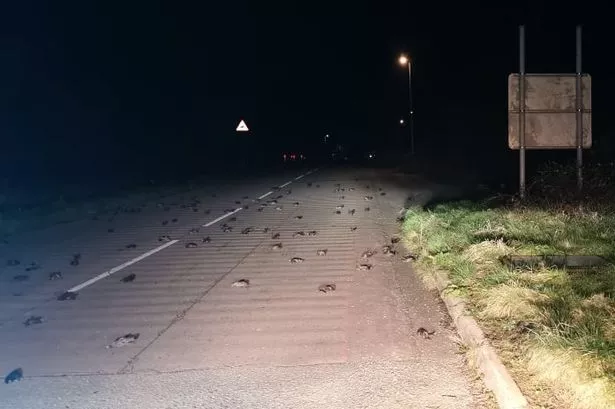
The dead starlings on the road (Image: Michaela Pritchard)
A woman driving home was greeted with an "eerie sight" as she came across dead birds lying on a road in Pembrokeshire.
Michaela Pritchard said it looked like a "massacre" as she travelled on the road between Waterston and Hazelbeach on Thursday evening.
There was seemingly little explanation for what caused around 200 birds to die so suddenly, with some pointing to the nearby Dragon LNG plant as a possible cause.
One man added he heard a loud bang before seven or eight birds rained down on his car in nearby Waterston.
People suggested other theories for why the birds had died, including electrocution or being chased by a bird of prey at dusk before hitting the road surface.
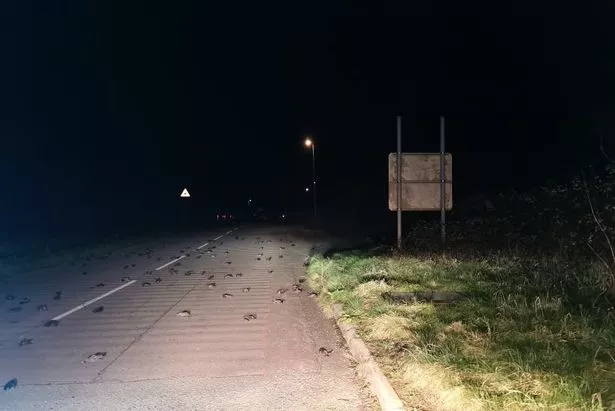
The dead starlings on the road (Image: Michaela Pritchard)
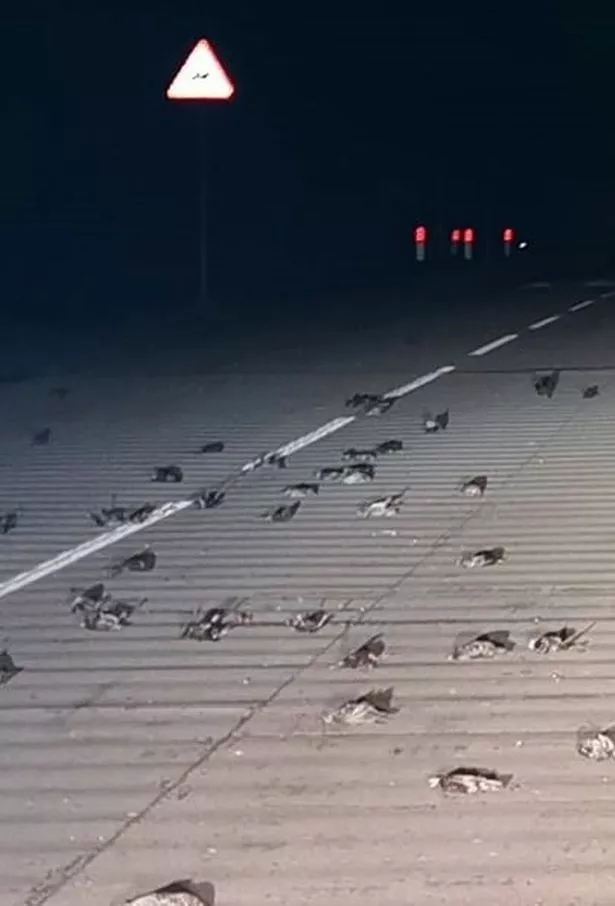
The dead birds made for an 'eerie' sight (Image: Michaela Pritchard)
Michaela said she didn't hang around as it was such an eerie sight and instead phoned Pembrokeshire council to report what she'd seen. She said they were already dead when she came across them at around 8pm.
Ian Mccaffrey works in Waterston and said some birds fell out of the sky onto his car just after he heard a large "electrical-type" bang. He said: "When I left work last night [Thursday] I heard a bang and then a load of birds landed on my car."
He reckoned at least six landed on the ground and added: "Every now and again you will hear a bang that is coming from what I think is a crow-scarer that farmers use. However this bang was more like an electrical bang - not quite as loud as lightning but similar.
"It’s like there were hundreds of birds in the sky and all of a sudden they just died and fell to the ground. It was quite surreal last night to be honest with you - not something I have ever experienced before."
Claire Eaton, who lives close to the road, went out at 11pm and said it was "traumatic" to see. She thought the birds had "died on impact" and even managed to scoop one of the stunned birds up and take it home, still alive. She's planning to release it later today.
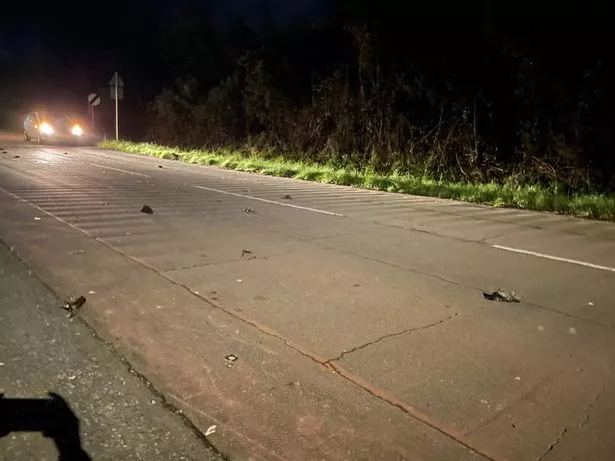
Claire Eaton said the whole experience was 'traumatic' (Image: Claire Eaton)
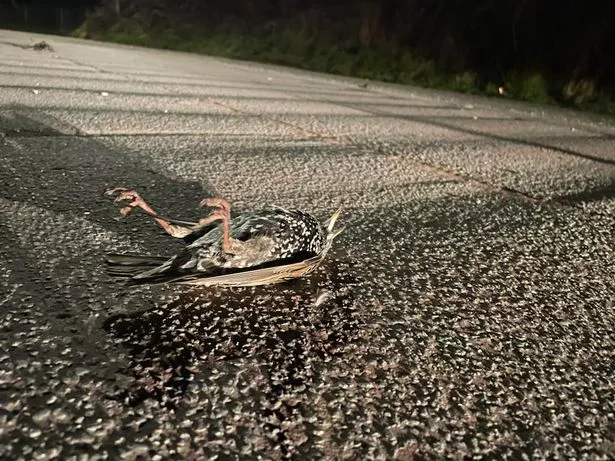
The starlings were dead as they hit the tarmac (Image: Claire Eaton)
"About an hour before I was at Neyland Marina walking my dog and I saw a big flash and I didn't think anything of it," she said. "Maybe something spooked them and they flew into the pylons."
The nature lover said she strongly believed that whatever was behind the incident was "manmade". She added: "I feel quite passionate about it - I think we should respect wildlife more in general."
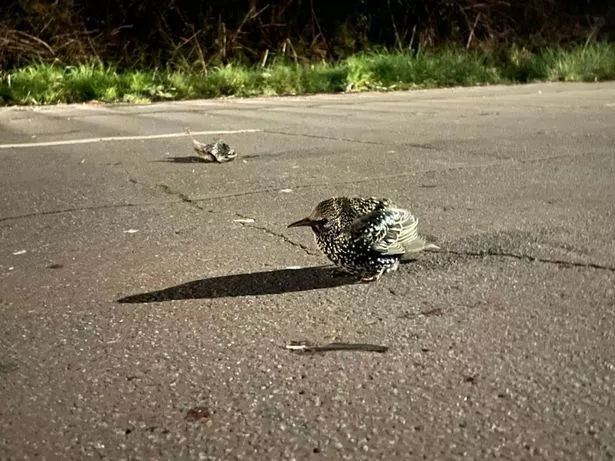
One starling survived (Image: Claire Eaton)
A spokesperson for Dragon LNG said there had been nothing unusual at the plant on Thursday and it was carrying on work as normal. She added: "It's in the vicinity but it's normal operations at Dragon LNG. There was nothing different at the plant."
Pembrokeshire Council said it was aware of the incident. A spokesman added: "We received a call at around 9pm on 10 February regarding a number of dead starlings on the Hazelbeach Road, Waterston.
"Officers attended the site and there were around 200 starlings found dead on the road. The authority undertook a clean-up and removed the dead birds from site.
"There is no clear indication as to the cause of these deaths. We have reported the incident to the Animal and Plant Health Agency."

